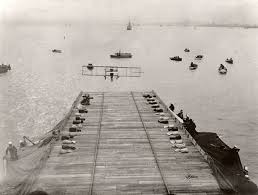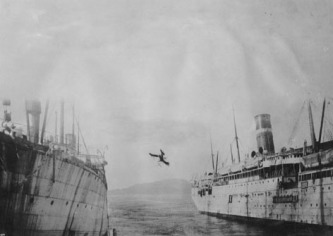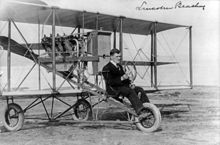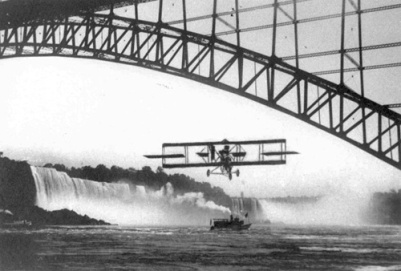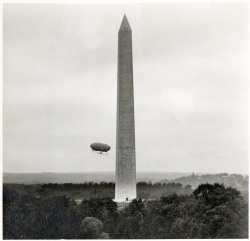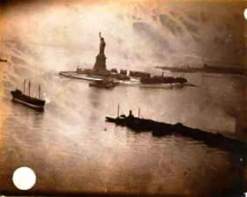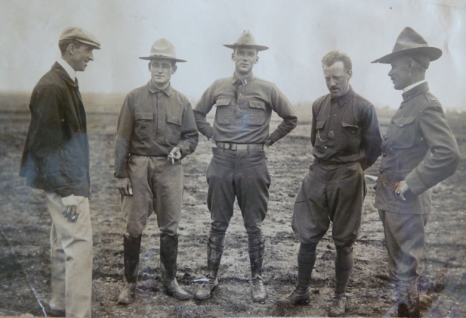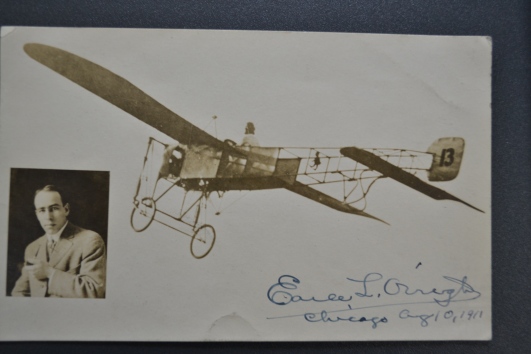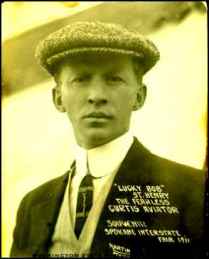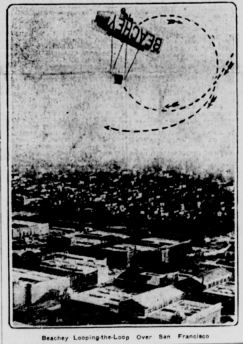
Lincoln Beachey spent the weeks following his sensational Niagara Falls flight by giving well-received exhibitions in western and upstate New York, and in western Pennsylvania. His wife had evidently returned home long before then, and Beachey was accompanied throughout this time by Miss Mae Wood, who gave her age as nineteen and who had first publicly appeared with him at the Wilkes-Barre exhibition in May. Miss Wood rode repeatedly with Beachey over the summer of 1911, with some newspapers delicately excusing her companionship through the explanation that she was “taking lessons on the management of air craft.” Though never seen at the controls of the machine, whenever she was asked about her most memorable flights she spoke of the rides with Beachey as if she had been operating the aeroplane.
In late July news broke that Beachey, Ely, and Hugh Robinson would take part in the first true intercity aeroplane race in America. Curtiss business manager Jerome Fanciulli had arranged for the Gimbel Brothers department store to sponsor a three-way, all-Curtiss air race between its New York and Philadelphia stores, with a prize of $5,000 to the winner. The race would take place on Saturday, August 5.
Although there was no particular novelty in the announced route—Charles K. Hamilton had flown solo from New York to Philadelphia and back again in June 1910—the race was nevertheless billed as an “epochal event” because of its format. And by the time Ely and Robinson reached the East Coast, there was a potential fourth entrant: Hamilton himself, who had recently resolved his differences with Curtiss and returned to the exhibition company. Certainly he was a logical entrant in the Gimbels race, given his historic round-trip flight. He pulled out at the last minute, however, for reasons that are unclear.
One at a time, the three aeroplanes left Governors Island that Saturday morning and disappeared north into a thick haze that covered the city. They passed over the official starting line, the New York Gimbel Brothers store, roughly ninety seconds apart, with Beachey leading and Ely second. Robinson had trouble locating the specific railroad tracks he needed to follow; by the time he reached Rahway, New Jersey, he was seven minutes behind the others, who were essentially flying together.
Ely soon developed engine trouble and abandoned the race. Beachey easily beat Robinson, crossing above the finish line (the Gimbels store in Philadelphia) with an elapsed time of 2:01, which included a scheduled stop for fuel in Trenton. As soon as he landed before a crowd estimated at 100,000, Beachey was “warmly greeted” (the more discreet reports characterized it as a “handshake”) by Mae Wood, wearing a stylish purple hat and a purple-and-white gown. Newspapers rightly lavished praise on him: “Lincoln Beachey, hero of hundreds of conquests of the air, won the cross-country air race from New York to Philadelphia this afternoon hands down.”
As the three Curtiss racers traveled to Chicago for the final major meet of the summer, Beachey had unquestionably elevated himself to the premier aviator in the country, winning even the admiration of veteran flyers. Lieutenant Ellyson attended the Chicago meet and reported back to the Navy’s aviation expert, Captain Chambers: “Beach[e]y’s flying was the most wonderful that I have ever seen.” Ellyson went on to say that Breachey
flew about 15 feet from the ground and when he rounded the pylons the turn was so short that it seemed as if he hooked one aileron on the pylon. At another time he and [Frenchman René] Simon were flying at an altitude of 4500 feet, and Simon is noted for his quick dashes back to the earth. Simon started on one of his glides but Beach[e]y waited until Simon was not over 1000 feet from the ground, made four complete spirals then seemed to dive straight to the ground, and landed while Simon was still 500 feet in the air. You could hear a sigh—an awful sound—go up from the crowd, because everyone thought that the machine had gotten beyond his control.
Beachey himself, “whose stunts at the present meet [were] declared by experts never to have been equaled in the history of air sport,” reportedly engaged in lengthy debates with newspapermen “in an attempt to prove that the spiral glide as he does it is not necessarily dangerous.”
Nonetheless, two aviation fatalities occurred at the Chicago meet that week. One of the deaths was that of a young Pittsburgh socialite, Bill Badger, who had recently earned his aviator’s license and who flew for Captain Baldwin’s exhibition team. On August 15 Badger kept diving repeatedly at the ground and pulling up sharply, an ill-advised attempt to copy Beachey’s manner of flying that ended when the wings of the Baldwin machine crumpled under the strain. Badger plowed into the ground at high speed and died of a broken neck.

“Jolly Bill Badger,” 26, killed in a crash at Chicago
Afterward, the aviation expert for the Chicago Tribune wrote soberly that Beachey, with his greater experience, “has been doing tricks successfully so far. . . . But all men fail some time.” If the sky was a type of precipice, Beachey was flying himself and others closer to the edge.
But the public’s appetite for this more dangerous form of flying seemed limitless. Even though the day following the Chicago fatalities was a Wednesday, one of the largest crowds of the meet jammed the aviation field—to say nothing of nearby streets, parking spaces, and the bleachers erected on roofs of high-rise buildings—“in the morbid hope that the spectacular accidents of Tuesday would be repeated.”
On previous days they had come to see mechanical contrivances shooting through the air. [Wednesday] they came to see live men, daring young aviators, hurtling to their death through space. They were disappointed, for only once did they rise to their feet and utter groans—half delight, half horror—as Lincoln Beachey shot from a height of nearly 3,000 feet and seemed to be rushing to his death with the speed of an express train.
Then when he settled easily with the wind a few feet above the ground and landed gracefully, cheer after cheer rang out. Exclamations of relief and sighs of satisfaction were heard on all sides. Every one was pleased, having witnessed a man shooting to earth and [having] experienced all the thrills of a great catastrophe without the toll of human life.
High winds limited the number of events that day, but “[f]ollowing Beachey’s spectacular drop, many [spectators] concluded that they had witnessed the most exciting event of the day and departed [happily].” Beachey won nearly $12,000 in prizes during the week of the Chicago exhibition, the equivalent of roughly $300,000 today. He went on to experience similar if somewhat less extravagant successes in September and October.
And he was constantly looking for new ways to entertain crowds. During the first couple of months of 1912 he created the character of a hitherto unknown French aviatrix, “Madame Cozette de Truse,” supposedly a rival of Blanche Scott (who was also appearing regularly at aviation meets by then). The mysterious aviatrix would fly erratically and comically in Beachey’s machine—and then, after “Madame” finally landed, Scott would grab at the Frenchwoman’s hair and pulled off a wig, revealing that the incomparable Beachey had flown in drag.
For the most part, however, during the first three or four months of 1912 Beachey “laid off” exhibitions but remained affiliated with the Curtiss team. Appalled by the trial court’s decision against Curtiss in the Wright brothers patent dispute, he apparently suggested an attempt, which Curtiss later carried out, to reconstruct Samuel P. Langley’s Aerodrome in order to disprove the validity of the Wright claims.
Beachey also became fascinated with the idea of completing an aerial loop, which had never been done and which the construction of his Curtiss machine would not accommodate. When Curtiss refused to build a machine specifically capable of looping, Beachey left the team to perform on his own.
Meanwhile, he was coming under great stress in his personal life. His wife tried to divorce him in June 1912, claiming that he had “acted improperly with other women in no [fewer] than nine cities” from 1908 to 1911; Mae Wood, who had by then disappeared from public view, was implicated. Unable to amass evidence to support her claim, Mrs. Beachey agreed to a reconciliation but filed a new suit in January 1913, alleging mental cruelty. A California court speedily granted the divorce decree.
Two months later, five days after his twenty-sixth birthday, Beachey made a highly publicized announcement of his retirement. He explained that he was haunted by the memory of the men who had died trying to copy his stunts, Ely supposedly among them. The timing of the divorce decree with Beachey’s retirement announcement perhaps was not a complete coincidence, given that California is and was a community property state; still, Beachey did seem genuinely remorseful.
His retirement lasted little more than six months. In September 1913, Russian Pyotr Nesterov and Frenchman Adolphe Pégoud each succeeded in completing an aerial loop. Curtiss thereafter relented and built the “looper” Beachey wanted. Its engine allowed him to fly upside down, while the seat was positioned as far forward as possible, essentially on top of the front wheel, as pictured in Part II.
During an unannounced early test flight with the new machine on October 7, 1913, Beachey lost control, clipped the ridgeline of a large canvas tent, and crashed. Ruth Hildreth was one of two sisters who, along with their Navy dates, had climbed onto the tent for a better view only moments before. When Beachey’s looper caught the tent Hildreth fell, striking her head on a parked automobile. She died soon afterward of a fractured skull.
Beachey had not invited spectators that day, nor was he found to have been attempting anything exceptional at the time, so the coroner exonerated him. Reports that he had gone back into retirement were wrong. On November 19, he succeeded in “looping the loop” for the first time, and on Christmas Day he strung together five consecutive loops.He soon had another, more maneuverable machine built. It had a rotary engine and was called the Little Looper. He had his name painted on the top of the upper wing, so spectators could more easily track the loop from the ground.
Beachey’s stunts demonstrated a remarkable control of his machine. In addition to flying upside down, he reportedly could land on the roof of a moving train or pick up a tented handkerchief on the ground with a hook attached to his wingtip. One apocryphal story had $300 in gold coins falling from his pockets to the ground as he flew inverted. He famously flew inside the grand Palace of Machinery while it was being constructed for the Pan-Pacific International Exhibition (PPIE) at San Francisco. He engaged in a series of staged races against famed automobile racer Barney Oldfield. He made a mock attack on Washington, more dramatic even than Claude Grahame-White’s 1910 landing on Executive Avenue, just to demonstrate how unprepared the nation was for aerial warfare.
Millions of people saw Beachey fly; his name was a byword. His personal income for 1914 alone was estimated to exceed $250,000 ($6.25M today). It was said of him that he made more in a single day than the average American worker could earn in a year.
In late 1914 Beachey finally revisited the monoplane configuration he had used in his initial attempts to fly five years earlier. The new machine, made especially for aerobatics, was constructed of aluminum and was designed to fly at 100 mph in level flight. Again, he had his name painted in large block letters on top of the wing.
After a short period of practice in March 1915, Beachey made his first public appearance with the new monoplane over San Francisco Bay. March 14 had been designated “Lincoln Beachey Day” by the PPIE directors. The crowd was enormous.
The “master birdman” soared to three thousand feet. When he went into a steep dive, however, the rear spars on both wings snapped and the wings collapsed, as had happened to Bill Badger nearly four years earlier.
Beachey plunged straight down into the water with such speed and force that his machine stuck in the muddy bottom some thirty feet under the surface. When divers recovered his body an hour later they discovered that, incredibly, he had survived the crash but—unable to free himself from the tangle of wires—had drowned.
Eleven days past his twenty-eighth birthday, Lincoln Beachey died in the city of his birth. His final flight took place above the same waters over which Eugene Ely passed four years earlier in the course of proving that an aircraft could safely land on a warship.
Beachey’s crumpled monoplane about to hit the water (March 14, 1915)
Lincoln Beachey & The Exhibition Era, Carroll Gray’s forthcoming biography, covers Beachey’s life and career in comprehensive detail. My thanks to Mr. Gray for reviewing these blog posts and offering clarifications.
